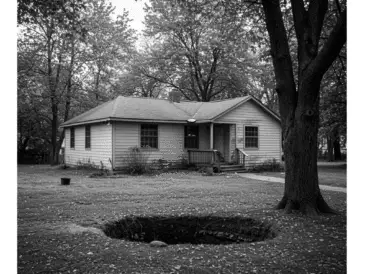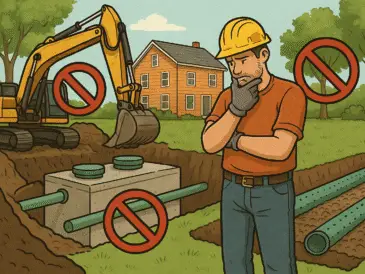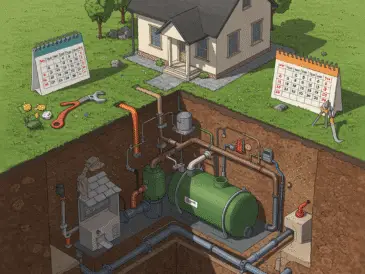Installing a new septic system is like choosing a life partner – you want someone reliable, experienced, and who won’t leave you dealing with unpleasant surprises down the road. With septic installation costs ranging from $3,000 to $15,000+ in 2025, selecting the right company isn’t just about finding the lowest bid; it’s about ensuring your investment will keep your waste management running smoothly for decades to come.
The septic industry has evolved significantly, with new technologies, stricter environmental regulations, and rising material costs reshaping the landscape. Whether you’re building a new home or replacing a failing system, this comprehensive guide will help you navigate the murky waters of septic installation companies, pricing structures, and regional considerations to make an informed decision that won’t leave you flushed with regret.
What to Look for in the Best Septic Installation Companies
Experience and Certifications
Experience in the septic world isn’t just about years in business – it’s about successfully navigating the complex web of soil conditions, local regulations, and system types. Look for companies with at least 10 years of experience and proper licensing in your state. Many states require specific certifications for septic installers, and the best companies will proudly display these credentials.
Don’t be shy about asking for proof of insurance, bonding, and workers’ compensation coverage. A reputable company will provide this information faster than you can say “percolation test.” Additionally, membership in professional organizations like the National Association of Wastewater Technicians (NAWT) or state-specific associations demonstrates a commitment to industry standards and ongoing education.
Service Offerings
The best septic installation companies offer comprehensive services that extend beyond just digging holes and dropping in tanks. Top-tier companies should provide soil testing and percolation tests, permit acquisition assistance, system design and engineering, excavation and installation, final inspections, and maintenance plan options.
Companies that offer design-build services can streamline your project timeline and reduce coordination headaches. They’ll handle everything from initial site evaluation through final inspection, ensuring all components work together seamlessly.
“The best septic companies don’t just install systems – they engineer solutions. Every property is unique, and cookie-cutter approaches lead to costly failures down the road.”
– Sarah Martinez, Licensed Environmental Engineer
Equipment and Technology Used
Modern septic installation requires more than a shovel and determination. Look for companies that use GPS technology for precise system placement, laser grading equipment for proper slope installation, and advanced compaction equipment to prevent settling issues. Companies investing in quality equipment typically deliver higher-quality installations.
Additionally, ask about the brands and types of septic components they install. Reputable companies work with established manufacturers like Infiltrator, Precast concrete suppliers, or advanced treatment system manufacturers like Advantex or SeptiTech.
Customer Reviews and Reputation
In today’s digital age, a company’s reputation is just a Google search away. Check multiple review platforms including Google Reviews, Better Business Bureau, Angie’s List, and local Facebook community groups. Pay attention to how companies respond to negative reviews – professional, solution-oriented responses indicate good customer service practices.
Ask for local references from recent customers and don’t hesitate to contact them. Most satisfied customers are happy to share their experiences, especially regarding project timeline, cleanliness, and post-installation support.
Pricing Factors for Septic Installation in 2025
Size and Type of the Septic System
System size directly correlates with your home’s bedroom count and expected wastewater volume. A typical 3-bedroom home requires a 1,000-gallon tank, while larger homes may need 1,250-1,500 gallon systems. Tank size affects both material and installation costs, with larger systems requiring more excavation and potentially additional permits.
System type significantly impacts pricing. Conventional gravity systems represent the most affordable option ($3,000-$7,000), while advanced treatment units or mound systems can cost $10,000-$20,000+. Alternative systems like aerobic treatment units, sand filter systems, or constructed wetlands command premium pricing due to complex installation requirements and specialized components.
Site Conditions and Accessibility
Your property’s unique characteristics heavily influence installation costs. Rocky soil conditions requiring blasting can add $2,000-$5,000 to your project. High water tables may necessitate mound systems or advanced drainage solutions. Steep slopes, tight access areas, or long distances from the road increase equipment and labor costs.
Soil percolation rates determine system type and complexity. Fast-percolating sandy soils typically allow conventional systems, while slow-percolating clay soils may require engineered solutions costing significantly more.
Regional Labor and Material Costs
Labor costs vary dramatically across regions. Metropolitan areas like San Francisco, New York, or Seattle command premium rates ($100-150+ per hour), while rural areas may see rates of $50-80 per hour. Material costs also fluctuate regionally due to transportation expenses and local supplier availability.
Northern climates require deeper installations to prevent freezing, increasing excavation costs. Coastal areas may have stricter environmental regulations requiring specialized systems or additional permits.
Additional Services
Many companies offer value-added services that, while increasing upfront costs, provide long-term benefits. Maintenance contracts ($200-500 annually) ensure regular pumping and inspections. Some companies offer extended warranties beyond standard manufacturer coverage. Landscaping restoration, driveway repair, or utility line protection may add $1,000-3,000 to your project but save headaches later.
Top 5 Best Septic Installation Companies in 2025
1. American Septic Solutions
Operating across 15 states, American Septic Solutions has built a reputation for reliability and comprehensive service offerings. Their pricing ranges from $4,500-$12,000 for standard installations, with premium services extending to $18,000+ for complex sites.
Services: Complete design-build services, soil testing, permit assistance, maintenance programs, and 24/7 emergency support. They specialize in both conventional and advanced treatment systems.
Pros: Extensive geographic coverage, strong warranty programs, certified technicians, and excellent customer service ratings. They offer financing options and detailed project timelines.
Cons: Premium pricing compared to local competitors, and limited availability in rural areas outside their core markets.
2. EcoFlow Septic Systems
Specializing in environmentally-friendly septic solutions, EcoFlow focuses on advanced treatment systems and sustainable practices. Their pricing ranges from $6,000-$15,000, reflecting their premium positioning in the market.
Services: Advanced treatment unit installation, ecological system design, soil remediation, and comprehensive environmental consulting. They’re leaders in innovative septic technologies.
Pros: Cutting-edge technology, environmental expertise, excellent for challenging sites, and strong relationships with regulatory agencies.
Cons: Higher costs than conventional installers, longer project timelines due to specialized systems, and limited conventional system offerings.
3. Reliable Waste Management Inc.
A family-owned business operating for over 30 years, Reliable focuses on residential and small commercial installations. Their pricing is competitive at $3,500-$9,000 for most projects.
Services: Traditional septic installation, pumping services, repair work, and basic maintenance. They excel at straightforward installations and have strong local relationships.
Pros: Competitive pricing, quick project completion, local expertise, and excellent value for standard installations.
Cons: Limited advanced system capabilities, smaller service area, and basic warranty coverage compared to larger competitors.
4. ProSeptic Engineering
Combining engineering expertise with installation services, ProSeptic handles complex projects requiring custom solutions. Their pricing ranges from $5,000-$20,000+ depending on system complexity.
Services: Custom system design, challenging site solutions, commercial installations, and regulatory compliance consulting. They’re specialists in problem-solving difficult installations.
Pros: Engineering expertise, capability for complex projects, strong regulatory relationships, and comprehensive project management.
Cons: Higher costs for standard projects, longer design phases, and may be overkill for simple installations.
5. Budget Septic Solutions
Focused on providing affordable septic installation services, Budget Septic maintains quality while keeping costs manageable. Their pricing ranges from $2,800-$7,500 for most installations.
Services: Basic septic installation, tank pumping, minor repairs, and permit assistance. They focus on efficient, cost-effective installations.
Pros: Competitive pricing, quick turnaround times, no-nonsense approach, and good value for budget-conscious customers.
Cons: Limited service offerings, basic warranty coverage, and may not handle complex or advanced systems.
“Don’t automatically choose the lowest bid. A septic system installed incorrectly will cost far more in repairs and replacements than investing in quality installation upfront.”
– Mike Thompson, Master Plumber and Septic Specialist
Service Comparison Table
| Company | Price Range | Key Services | Coverage | Rating |
|---|---|---|---|---|
| American Septic Solutions | $4,500-$18,000 | Full service, maintenance | 15 states | 4.6/5 |
| EcoFlow Septic | $6,000-$15,000 | Advanced systems, eco-friendly | 8 states | 4.8/5 |
| Reliable Waste Management | $3,500-$9,000 | Traditional systems, local | Regional | 4.4/5 |
| ProSeptic Engineering | $5,000-$20,000+ | Custom design, complex sites | 6 states | 4.7/5 |
| Budget Septic Solutions | $2,800-$7,500 | Basic installation, affordable | Multi-state | 4.2/5 |
Regional Breakdown of Septic Installation Services
Northeast
The Northeast region faces unique challenges including rocky soil conditions, strict environmental regulations, and higher labor costs. Average installation costs range from $5,000-$15,000, with premium systems reaching $20,000+. States like Massachusetts and Connecticut have particularly stringent requirements for nitrogen reduction, often requiring advanced treatment systems.
Winter installation challenges and shorter construction seasons can impact pricing and scheduling. Many companies in this region specialize in difficult site conditions and have extensive experience with ledge removal and challenging access situations.
South
Southern states generally offer more favorable installation conditions with easier soil excavation and longer construction seasons. Pricing tends to be more competitive, ranging from $3,500-$10,000 for most installations. However, high water tables in coastal areas and clay soil conditions in some regions can complicate installations.
States like Florida and Louisiana have specific requirements for high water table situations, often requiring pump systems or specialized designs. The longer construction season allows for more competitive pricing and faster project completion.
Midwest
The Midwest offers relatively straightforward installation conditions with good soil composition and moderate regulatory requirements. Pricing typically ranges from $3,000-$8,000 for standard systems. Clay soil conditions in some areas may require engineered solutions.
Harsh winter conditions limit installation seasons but generally result in competitive pricing during construction months. Many Midwest companies offer excellent value and have strong reputations for quality workmanship.
West
Western states present diverse conditions from California’s strict environmental regulations to the challenging mountain terrain of Colorado and Wyoming. Pricing varies dramatically from $4,000-$12,000 in rural areas to $8,000-$20,000+ in metropolitan regions.
California’s advanced treatment requirements, water conservation mandates, and seismic considerations significantly impact system design and costs. Mountain regions face challenges with rocky soil, limited access, and seasonal construction limitations.
Tips for Choosing the Right Septic Installation Company
Requesting Multiple Quotes
Always obtain at least three detailed quotes from different companies. Ensure each quote includes the same scope of work for accurate comparison. Be wary of quotes significantly higher or lower than others – both can indicate potential issues.
Quality quotes should include detailed breakdowns of materials, labor, permits, and any additional services. Ask about potential additional costs and get clarification on what scenarios might trigger change orders.
Validating Credentials and Insurance
Verify all licenses, certifications, and insurance coverage before signing contracts. Check with your state’s licensing board to ensure credentials are current and investigate any complaints or violations. Require proof of liability insurance and workers’ compensation coverage.
Don’t hesitate to contact insurance providers directly to verify coverage amounts and policy status. This simple step can save you from significant liability if accidents occur during installation.
Checking Local Regulations and Permits
Understand your local septic requirements and ensure your chosen company has experience with local regulations. Some companies may not be familiar with specific municipal requirements or may cut corners on permit procedures.
Verify that all necessary permits will be obtained and that the company will handle inspections and approvals. Ask about timeline expectations for permit approval, as this can significantly impact project scheduling.
Understanding Warranty and Follow-Up Support
Review warranty terms carefully, understanding what’s covered and for how long. Standard warranties typically cover workmanship for 1-2 years, while material warranties vary by component. Some companies offer extended warranty options for additional peace of mind.
Ask about post-installation support, maintenance recommendations, and emergency service availability. Companies that offer ongoing relationships tend to stand behind their work more strongly.
“The relationship with your septic installer doesn’t end when the last shovelful of dirt is placed. Choose a company you’ll want to work with for maintenance and future needs.”
– Jennifer Rodriguez, Environmental Health Specialist
Frequently Asked Questions
How long does septic installation typically take?
Most residential septic installations take 3-7 days from excavation to final inspection, depending on system complexity and site conditions. Permit approval can add 2-6 weeks to the overall timeline.
What’s the difference between conventional and advanced treatment systems?
Conventional systems use gravity and soil filtration for wastewater treatment, while advanced systems employ mechanical components, pumps, or engineered media to achieve higher treatment levels. Advanced systems cost more but may be required in sensitive environmental areas.
Can I install a septic system myself?
While some states allow homeowner installation, most require licensed professionals for safety and environmental protection reasons. DIY installation risks code violations, system failure, and potential environmental damage.
When is the best time to install a septic system?
Late spring through early fall typically offers the best installation conditions. Avoid winter installation in northern climates due to frozen ground conditions and potential weather delays.
How often should I pump my new septic tank?
Most residential septic tanks require pumping every 3-5 years, depending on household size and usage patterns. Your installer should provide specific recommendations based on your system and circumstances.
Conclusion
Choosing the right septic installation company requires balancing cost, quality, and service offerings while considering your specific site conditions and local requirements. The companies highlighted in this guide represent different approaches to septic installation, from budget-conscious options to premium engineering solutions.
Remember that septic installation is a long-term investment in your property’s infrastructure. While cost is certainly important, factors like experience, reputation, warranty coverage, and ongoing support often provide greater value over the system’s 20-30 year lifespan.
Take time to research thoroughly, obtain multiple quotes, and verify credentials before making your decision. A properly installed septic system will provide decades of reliable service, while a poorly installed system can result in costly repairs, environmental issues, and significant headaches. Invest in professional installation services – your future self (and your wallet) will thank you for making the right choice from the start.




